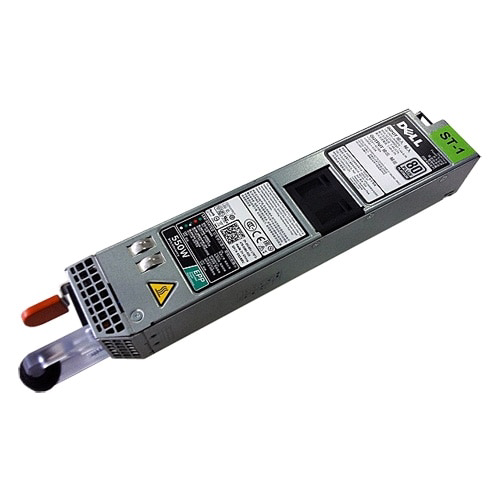The Dell 550-Watt Hot-Plug Server Power Supply is a dependable and efficient power supply that delivers consistent and adequate power to your server system. The Dell 550W Server Power Supply has a 550W output power and can power a variety of server components and devices. It offers an input voltage range of 100–240 volts AC, allowing it to adapt to various power sources and areas. It has a Platinum 80 Plus rating, which implies it is energy efficient and produces little heat. There are multiple Dell PowerEdge servers that are compatible with the Dell 550-Watt Hot-Plug Server Power Supply, including the R330, R340, R430, R440, R6415, R6515, and XR2. These servers are made to handle a wide range of tasks and uses, including cloud computing, virtualization, web hosting, and databases. With an optional power supply, the device’s 1+1 power redundancy strategy allows it to function with a backup power source to minimize downtime in the event of a power outage. Because of its hot-plug, plug-in module power supply type, the device is simple to install or remove without requiring the system to be turned down.
Dell 550-Watt Hot-Plug Server Power Supply
Key Features
- Model: Dell 550-Watt
- Output Power: 550 Watts
- Input Voltage: 100-240V AC
- Minimum input voltage: 100 volts
- Server Compatibility: R330, R340, R430, R440, R6415, R6515, XR2
27,000.00৳
18
People watching this product now!
Product Description
Dell 550-Watt Hot-Plug Server Power Supply
Key Features
- Model: Dell 550-Watt
- Output Power: 550 Watts
- Input Voltage: 100-240V AC
- Minimum input voltage: 100 volts
- Server Compatibility: R330, R340, R430, R440, R6415, R6515, XR2
27,000.00৳
13
People watching this product now!
Description
Description
The Dell 550-Watt Hot-Plug Server Power Supply is a dependable and efficient power supply that delivers consistent and adequate power to your server system. The Dell 550W Server Power Supply has a 550W output power and can power a variety of server components and devices. It offers an input voltage range of 100–240 volts AC, allowing it to adapt to various power sources and areas. It has a Platinum 80 Plus rating, which implies it is energy efficient and produces little heat. There are multiple Dell PowerEdge servers that are compatible with the Dell 550-Watt Hot-Plug Server Power Supply, including the R330, R340, R430, R440, R6415, R6515, and XR2. These servers are made to handle a wide range of tasks and uses, including cloud computing, virtualization, web hosting, and databases. With an optional power supply, the device’s 1+1 power redundancy strategy allows it to function with a backup power source to minimize downtime in the event of a power outage. Because of its hot-plug, plug-in module power supply type, the device is simple to install or remove without requiring the system to be turned down.
Reviews (0)
Rated 0 out of 5
0 reviews
Rated 5 out of 5
0
Rated 4 out of 5
0
Rated 3 out of 5
0
Rated 2 out of 5
0
Rated 1 out of 5
0
Be the first to review “Dell 550-Watt Hot-Plug Server Power Supply” Cancel reply
Customer Reviews
Rated 0 out of 5
0 reviews
Rated 5 out of 5
0
Rated 4 out of 5
0
Rated 3 out of 5
0
Rated 2 out of 5
0
Rated 1 out of 5
0
Reviews
Clear filtersThere are no reviews yet.
Be the first to review “Dell 550-Watt Hot-Plug Server Power Supply” Cancel reply
Online Sports Nutrition and Natural Dietetics.
Chances are there wasn't collaboration, communication, and checkpoints, there wasn't a process agreed upon or specified with the granularity required. It's content strategy gone awry right from the start. Forswearing the use of Lorem Ipsum wouldn't have helped, won't help now. It's like saying you're a bad designer, use less bold text, don't use italics in every other paragraph. True enough, but that's not all that it takes to get things back on track.
The villagers are out there with a vengeance to get that Frankenstein
You made all the required mock ups for commissioned layout, got all the approvals, built a tested code base or had them built, you decided on a content management system, got a license for it or adapted:
- The toppings you may chose for that TV dinner pizza slice when you forgot to shop for foods, the paint you may slap on your face to impress the new boss is your business.
- But what about your daily bread? Design comps, layouts, wireframes—will your clients accept that you go about things the facile way?
- Authorities in our business will tell in no uncertain terms that Lorem Ipsum is that huge, huge no no to forswear forever.
- Not so fast, I'd say, there are some redeeming factors in favor of greeking text, as its use is merely the symptom of a worse problem to take into consideration.
- Websites in professional use templating systems.
- Commercial publishing platforms and content management systems ensure that you can show different text, different data using the same template.
- When it's about controlling hundreds of articles, product pages for web shops, or user profiles in social networks, all of them potentially with different sizes, formats, rules for differing elements things can break, designs agreed upon can have unintended consequences and look much different than expected.
This is quite a problem to solve, but just doing without greeking text won't fix it. Using test items of real content and data in designs will help, but there's no guarantee that every oddity will be found and corrected. Do you want to be sure? Then a prototype or beta site with real content published from the real CMS is needed—but you’re not going that far until you go through an initial design cycle.























Reviews
Clear filtersThere are no reviews yet.